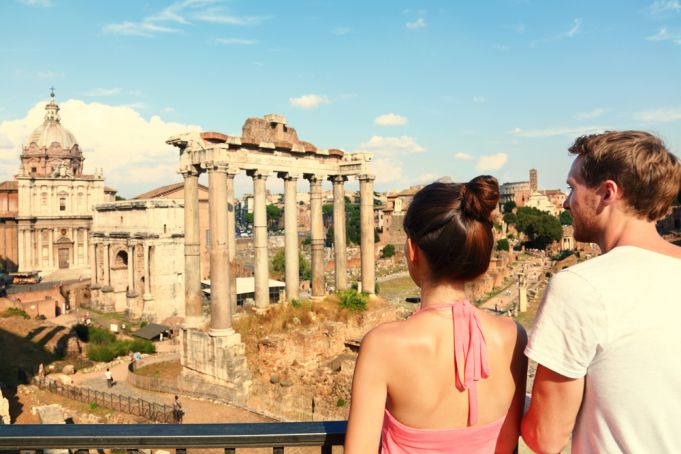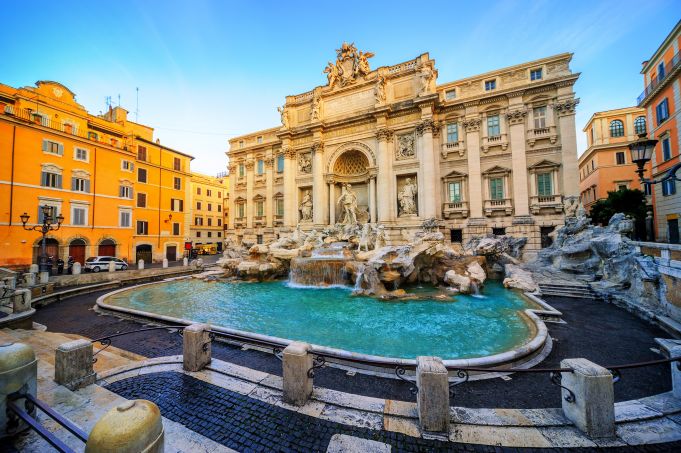With a little leap of the imagination, Rome becomes a giant amusement park.
“Its original name is the Flavian Amphitheatre.” The guide points at the Colosseum, once the world’s largest stadium. She then explains that the floor, which once hosted animal fights and sea battles, will soon host cultural events of the highest level.The group is gathering beside a panini van. On its counter shimmers a large jar of Nutella.
“Look over there,” one of the tour participants says and indicates a couple of centurions: “cast members!”
The tour guide continues: “And this is the main avenue, called Via dei Fori Imperiali. It runs right through the heart of the ancient empire.” The road connects the former stadium to the city hall. A dressed-up horse carriage with a robed rider trots by. Its passengers admire the remains of government buildings, places of worship and a marketplace.
“So dad,” a young man asks the adult standing beside him, “this is Rome’s Main Street USA?”
In the travel agency, when the father explained the family had visited both Disneyland and Las Vegas and that now he wanted something different for him and his son Jeb, who is a freshman at Cornell, the sales agent suggested heritage tourism. The Rome package attracts ten million visitors per year.

The tour group advances slowly: on each side of the road, a steady flow of visitors shuffles to and from the Colosseum. Street musicians are playing popular tunes. When the group passes a mime actor, one of the tour participants asks Jeb to take his picture: "I had one with Mickey. Now I want one with Caesar."
Under a Mediterranean sun the crowd rambles carelessly. Military jeeps block the road beside the Colosseum; a police car patrols the stretch up to the Capitol. At the entrance of the underground station, police officers are evacuating tall black Nubians and Indian-looking women wearing long, colourful skirts: citizens of distant Roman colonies?
While some tour participants wonder whether Trajan's Markets once looked like the Forum Shops in Vegas, others are discussing tomorrow’s schedule in Florence. Yet everybody wants to see the main attraction: St Peter’s Basilica. Apparently, it is as imposing and white as the Castle of Sleeping Beauty.
Jeb consults his smartphone: “In Main Street USA, Walt had the ground floors built to full scale and succeeding floors built proportionally smaller.” The group climbs the stairs that lead to the Campidoglio. “Jeb, did you know this?” His father reads out from his travel guide: “Michelangelo used optical illusions such as the trapezium shape of the square and the pattern of lines.”
Before the group turns off the Via dei Fori Imperiali, the guide halts. “For the younger guests, the tour offers a detective game in the Forum. It starts at 15.00 sharp.”
In Piazza Venezia, red double-deckers with national flags painted on both sides are humming. The tour guide explains that guests can choose from several tours: Ancient Rome, Baroque Rome and Papal Rome. “Dad, do you remember the traffic circle where you could choose between Adventure Land, Frontier Land and Tomorrow Land?” Jeb asks. “Let us this time go our own way.”
Father and son decide to explore Via del Corso, Rome’s high street. In the official Rome store, the father buys a t-shirt displaying “I heart Rome.” The duo follows the arrows that indicate the attractions. Every attraction goes with a compelling story or astonishing facts, and is surrounded by food and drink establishments.
Halfway down Via del Corso, the giggling of children can be heard from a gelateria. Their t-shirts are smudged with green. The children are taking an ice cream-making class and pistachio seems to be the favourite. For those children who do not like their self-made ice cream, there is Nutella. Meanwhile, the restaurant next door is offering the parents a class in pasta cooking. Visitor groups zoom by on Segways. Jeb and his father get on the shuttle bus.
When the bus arrives at a vast square, all passengers alight. In the middle of the square, adults are riding a lion. They scream and throw water at each other. All the time, people are taking pictures.
Jeb and his father take a back-alley. A penthouse offers the view from a famous scene of a Hollywood movie –“the VIP section of this tour allows you to visit the apartment.” Reading his travel guide, Jeb’s father remarks: “We’ve seen Trevi in Vegas, but Rome seems to have the original.”
Jeb has an idea. “Excuse me,” he asks a passerby, “could you please tell us where we can find this fountain?” He shows the man a picture on his smartphone. “It’s the Todd’s fountain.”
“The Todd’s fountain? Are you sure?” the man asks puzzled. Jeb shows him the picture. “Oh, I see,” the man says. “È Trevi.”

As father and son are approaching the Trevi Fountain, the streets become ever more crowded. All of a sudden, a water spectacle pops up in front of their eyes. In front of it, girls are pushing another aside to take the perfect selfie. Two of them get into a row. Jeb and his father are amazed. Can’t beat the real thing, can you?
At 19.00 sharp, the tour offers a Private Experience: “Meet a large family who lives in a typical blue-collar neighbourhood and experience the warmth of everyday Roman life. Listen to their stories on how they struggle to get by. Become a local among locals.”
Jeb’s father looks the neighbourhood up in his travel guide: “the solid working-class neighbourhood… a tight-knit community”. “So visitors expect each local to dress and behave as to confirm their expectations,” he wonders.
Jeb and his father are starving. They head to Trastevere. In the cobble-stoned streets, cosy restaurants alternate with slick wine shops. One of the bars has two old-timer Fiats on display. Amid all these places of leisure lie property agencies, their ads written in English.
In the pizzeria Il Simulacro, Jeb favours a traditional Four Seasons over the restaurant’s specialty, La Nutellaccia.
“Dad, I’m so happy we did Rome. I’ve learnt a lot. More than my marketing books could ever teach me."
“Marketing?”
“I recognise every concept we have studied,” Jeb continues. “For instance, didn’t you notice that museums and landmark sites have copied Disney’s queue management techniques?”
“Yes, I have.” The father nods. “But this is authentic whereas Disney is staged.”
“A former arena hosting cultural events of the highest order?” Noticing his father’s puzzlement, Jeb points at his t-shirt: “You see, cities are becoming brands. They have logos and position themselves in the market.”
“Right.”
“And now they are diversifying their offering by turning a nostalgic idea of urban life into a tourist experience,” Jeb argues passionately. “Take this.” The wall next to their table exhibits black-and-white ads of a famous coffee brand that evoke the hardship and closeness of post-war Italy. “In what way do these differ from the retro Coca Cola ads in Disneyland?”
“The next thing will be charging visitors an entrance fee,” Jeb explains. “Cities will apply price differentiation: the fee will vary depending on the day and time of visit.”
Back on Via dei Fori Imperiali, by now illuminated, a woman wearing a safari hat runs waving at Jeb and his father. She looks panicked. Jeb recognises the woman from the tour.
“You were on the same tour as I was,” she says. “Remember? You do? Thank God!” She is almost out of breath. “These cast members don’t understand me. Do you know when Rome closes?”
“What do you mean?” the father asks.
“I am not staying in a hotel inside the park. I am outside, in the Sheraton,” she explains. “Do you know at what time Rome closes?”
By Mike Dilien
This article was published in the February 2020 edition of Wanted in Rome magazine.



















